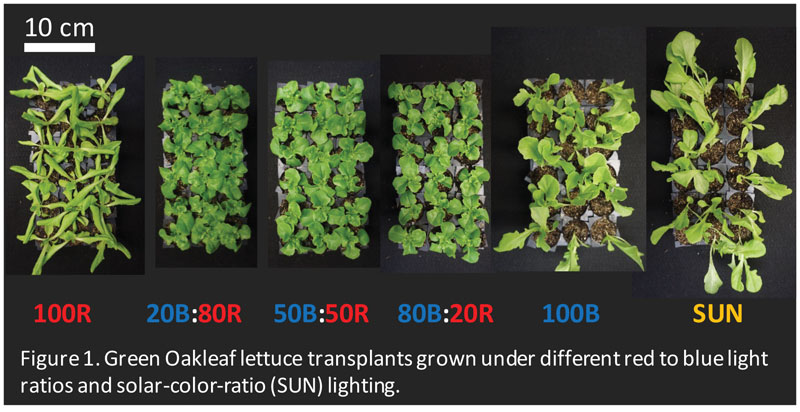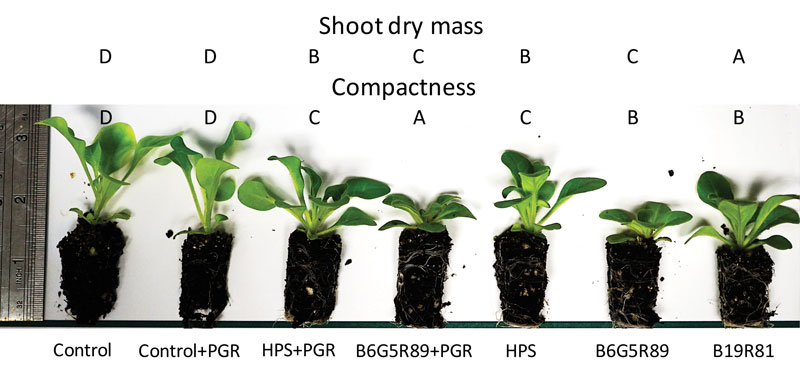1/1/2018
Signal to Grow
Ricardo Hernández, Hans Spalholz & Cristian Collado
Vegetable and ornamental transplants/seedlings are a key component for crop production. High-quality transplants can increase plant yield, decrease production time, improve early establishment of crops and decrease plant stress while been transplanted.
In the U.S., specialized propagators often do seedling/transplant production; propagators ensure that transplants have quality, uniformity and that there’s sufficient quantity at a specified time. Since transplants are considered a “high-value crop,” propagators are often open to the adoption of new technology.
The interest of using LED lighting for transplant production keeps increasing. LEDs can be used as supplemental lighting in the greenhouse or as a sole-source light under indoor propagation (vertical farm propagation). LEDs aren’t only the most efficient option to provide light to plants, but also fixtures can be built with customized spectrums to improve plant growth and development. Research on plant responses to light under supplemental lighting and sole-source lighting continues to evolve, and growers and researchers alike keep learning more. Below, we share with you some examples of how light signals can improve a transplant’s growth and morphology.
For veggies
Greenhouse and outdoor vegetable production (lettuce, tomatoes, cucumbers, peppers) relies more and more on starting out production with transplants instead of direct seeding into soil or growing media. For example, with lettuce, using transplants can increase the amount of production cycles on a given plot simply by reducing overall production time (growing from the transplant stage to harvest is weeks shorter than the time from seeding to harvest). Lettuce transplants can also exhibit traits that prepare them to establish quickly so the transplant can utilize available sunlight (e.g., a high dry mass to fresh mass ratio, lowered shoot-to-root ratio, lowered specific leaf area).
We’ve explored the possibility of the production of transplants under highly controlled growing systems where all the light is provided by LED fixtures. We carried out an experiment where we tested different light spectrums, mainly focusing on blue and red diodes, but also integrating other light spectrums, including one simulating the solar-color-ratios.
The lettuce seedlings were grown until the transplant stage for 18 days. We’ve found that a light spectrum composed of 20% blue and 80% red produces lettuce transplants with the highest quality (high growth rate and adequate morphology). Germination was performed with continuous fluorescent light at 80 μmol m-2 s-1 for two days and then moved to an indoor chamber with an average of 100 μmol m-2 s-1 for seven days followed by an increase to 200 μmol m-2 s-1 for nine days, both at 18 hours photoperiod (Figure 1).
 The production of high-wire vegetable transplants for greenhouses (tomato, cucumber, bell pepper) often requires supplemental lighting since the propagation is during the months of low solar radiation. LED supplemental lighting can also be used to improve plant morphology.
The production of high-wire vegetable transplants for greenhouses (tomato, cucumber, bell pepper) often requires supplemental lighting since the propagation is during the months of low solar radiation. LED supplemental lighting can also be used to improve plant morphology.
For example, while growing cucumber transplants under red and blue supplemental lighting, we found that plants under the blue LED spectrum had 46% greater plant height than in the red treatment, but with the same growth rate (Figure 2, average 57 μmol m-2 s-1 supplemental lighting at 18 hours photoperiod - 0200 to 2000 HR). Compact plants have a lower incidence of getting damaged during handling, and also, more plants can be shipped per tractor-trailer.
Figure 2. Plants grown under supplemental blue and red LED lighting.
For ornamentals
Ornamental seedling production can also be improved by the use of supplemental LED light. Typically, ornamental propagators look for strategies to increase plug compactness, which is the ratio between plant growth and plant height (dry mass of the plant (g)/height of plant [cm]).
One versatile solution is to apply chemical plant growth regulators (PGRs) to reduce plant height, however, some PGRs are considered toxic to aquatic invertebrates. A potential alternative is the use of supplemental lighting to improve plant growth and decrease plant height. This strategy takes advantage of how specific light spectrum impacts the morphology of the plant.
Supplemental lighting can be used separately or in conjunction with PGRs. For example, when comparing plant compactness and plant growth rate of petunia (Petunia Dreams Midnight), we found that the effect of supplemental lighting (average 100 μmol m-2 s-1 at 16 hours photoperiod - 0600 to 2200 HR) is evident and the type of light (spectrum) also affects plant growth and morphology (Figure 3).
 Figure 3. Plants grown under solar light (control) and supplemental lighting with and without chemical plant growth regulators (PGR). Different letters represent significant differences between the growing conditions, A>B>C>D.
Figure 3. Plants grown under solar light (control) and supplemental lighting with and without chemical plant growth regulators (PGR). Different letters represent significant differences between the growing conditions, A>B>C>D.
In this experiment, we tested seven treatments with combinations of supplemental lighting and a PGR application: plants grown under solar light only (Control); solar light plus the application of PGR (Control+PGR); HPS supplemental lighting only (HPS); HPS supplemental lighting with PGR application (HPS+PGR); supplemental LED with 6% blue, 5% green and 89% red light without (B6G5R89) and with PGRs (B6G5R89+PGR); and supplemental LED with 19% blue and 81% red (B19R81). The PGR treatments consisted of one application of Paclobutrazol at a rate of 10 mg•L-1.
The results showed that plants without supplemental lighting had less growth and less plant compactness with and without PGRs. In addition, plants under the two LED treatments were more compact than plants under the HPS treatment.
An interesting result was the effect of LED light quality to plant compactness. For example, plants under an LED containing blue, white and red diodes (B6G5R89) were more compact, but had less growth than plants under the LED with only blue and red diodes (B19R81). This could be a cultivar-specific response and we’re currently investigating how and why a small change in the spectrum can cause such a difference in plant response.
Plant responses to light spectrum are sometimes species specific, this specificity opens the possibility to fully harness the power of light signals by matching spectrum to specific cultivars, or group of cultivars, in order to improve transplant outcome (growth rate, morphology, development).
With the constant and continual improvement of LED fixtures (increased μmol J-1) in conjunction with the development of better interfaces to control and program LED lights, we envision one day automatically adjusting the light spectrum through the plant growth cycle (dynamic lighting) to optimize plant growth, morphology, development, nutritional content and flavor. GT
Ricardo Hernández, Hans Spalholz and Cristian Collado are students in the Department of Horticultural Sciences at North Carolina State University.